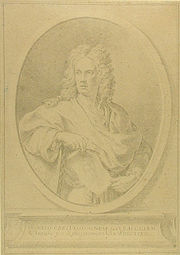
Donato Creti
Encyclopedia

Italy
Italy , officially the Italian Republic languages]] under the European Charter for Regional or Minority Languages. In each of these, Italy's official name is as follows:;;;;;;;;), is a unitary parliamentary republic in South-Central Europe. To the north it borders France, Switzerland, Austria and...
painter of the Rococo
Rococo
Rococo , also referred to as "Late Baroque", is an 18th-century style which developed as Baroque artists gave up their symmetry and became increasingly ornate, florid, and playful...
period, active mostly in Bologna
Bologna
Bologna is the capital city of Emilia-Romagna, in the Po Valley of Northern Italy. The city lies between the Po River and the Apennine Mountains, more specifically, between the Reno River and the Savena River. Bologna is a lively and cosmopolitan Italian college city, with spectacular history,...
.
Born in Cremona
Cremona
Cremona is a city and comune in northern Italy, situated in Lombardy, on the left bank of the Po River in the middle of the Pianura Padana . It is the capital of the province of Cremona and the seat of the local City and Province governments...
, he moved to Bologna, where he was a pupil of Lorenzo Pasinelli
Lorenzo Pasinelli
Lorenzo Pasinelli was an Italian painter from Bologna of the Baroque period, who trained in the studio of Simone Cantarini....
. He is described by Wittkower as the "Bolognese Marco Benefial
Marco Benefial
Marco Benefial was an Italian, proto-Neoclassical painter, mainly active in Rome. Benefial is best known for his repudiation of 18th century decorative Rococo styles pre-eminent in the Rome dominated by Carlo Maratta pupils....
", in that his style was less decorative and edged into a more formal neoclassical
Neoclassicism
Neoclassicism is the name given to Western movements in the decorative and visual arts, literature, theatre, music, and architecture that draw inspiration from the "classical" art and culture of Ancient Greece or Ancient Rome...
style. It is an academicized
Academic art
Academic art is a style of painting and sculpture produced under the influence of European academies of art. Specifically, academic art is the art and artists influenced by the standards of the French Académie des Beaux-Arts, which practiced under the movements of Neoclassicism and Romanticism,...
grand style, that crystallizes into a manneristic neoclassicism, with crisp and frigid modeling of the figures. Among his followers were Aureliano Milani
Aureliano Milani
Aureliano Milani was an Italian painter of the late-Baroque period, active in Bologna and Rome.He was a pupil of Cesare Gennari and Lorenzo Pasinelli in Bologna, although he also adhered to a style derived from the Carracci. He took up his residence in Rome, being ill able to support a family of...
, Francesco Monti
Francesco Monti (Bologna)
Francesco Monti was an Italian painter, of the late-Baroque.Born in Bologna, and first a pupil of Sigismondo Caula in Modena , then of Giovanni Gioseffo dal Sole in Bologna. He worked in Brescia, starting in 1738, painting frescoes on the vault of the church of Santa Maria della Pace. In 1741 he...
, and Ercole Graziani the Younger
Ercole Graziani the Younger
Ercole Graziani the Younger was an Italian painter of the Baroque period, active mainly in Bologna and Piacenza.He was a pupil of the painter Donato Creti and Marcantonio Franceschini. Pope Benedict XIV ordered a copy of his St. Peter consecrating St. Apollinaire for the church of Sant'Apollinare...
. Two other pupils were Domenico Maria Fratta and Giuseppe Peroni
Giuseppe Peroni
Giuseppe Peroni was an Italian painter of the Baroque period.He was born in Parma, but studied in Bologna as an apprentice of the painters Felice Torelli and Donato Creti, then moved to Rome to work with Agostino Masucci. He painted in the pre-eminent style of his time, the grand manner of Carlo...
.
Astronomical canvases
One memorable conceit in Creti's output is a series of small canvases depicting celestial bodies, disproportionately sized and illuminated, above nocturnal landscapes. The paintings, commissioned in 1711 by the Bolognese count Luigi Marsili and intended as a gift to Pope Clement XIPope Clement XI
Pope Clement XI , born Giovanni Francesco Albani, was Pope from 1700 until his death in 1721.-Early life:...
, were meant to accentuate the need for the Papal States to sponsor an astronomical observatory. With the support of Clement XI, the first public astronomical observatory in Italy was opened in Bologna a short time later. The eight small canvases display the sun, moon, Mercury, Venus, Mars, Jupiter, Saturn, and a comet. Uranus was not discovered until 1781. His Jupiter depicts the Great Red Spot (first reported in 1665) and at least two moons http://mv.vatican.va/3_EN/pages/x-Schede/PINs/PINs_Sala15_08_059.html.
Other works
- Cleopatra at Blanton Museum, Austin, Texas
- Alexander Threatened by his Father at the National Gallery of ArtNational Gallery of ArtThe National Gallery of Art and its Sculpture Garden is a national art museum, located on the National Mall between 3rd and 9th Streets at Constitution Avenue NW, in Washington, DC...
, Washington, D.C. - Artemisia Drinking the Ashes of Mausolus at the National GalleryNational galleryThe National Gallery is an art gallery on Trafalgar Square, London, United Kingdom.National Gallery may also refer to:*Armenia: National Gallery of Armenia, Yerevan*Australia:**National Gallery of Australia, Canberra...
, London - Achilles Handed over to Chiron at Palazzo d'AccursioPalazzo d'Accursiothumb|260px|Palazzo d'Accursio.Palazzo d'Accursio is a palace in Bologna, Italy. It is located on the Piazza Maggiore and had been the city's Town Hall until 11 November 2008....
, Bologna - Education of Achilles at Palazzo d'Accursio, Bologna
- Mercury and Paris at Palazzo d'Accursio, Bologna
- Charity at Palazzo d'Accursio, Bologna
- Allegorical Tomb of Boyle, Locke, and Sydenham at Pinacoteca Nazionale di Bologna
- Allegorical Tomb of the Duke of Marlborough at Pinacoteca Nazionale di Bologna
- Landscape with Female Figures at Pinacoteca Nazionale di Bologna
- Visitation of the Virgin to Saint Elizabeth at Pinacoteca Nazionale di Bologna
- Achilles Dipped in the Styx at Pinacoteca Nazionale di Bologna
External links
- Gallery including images of the astronomical canvases

